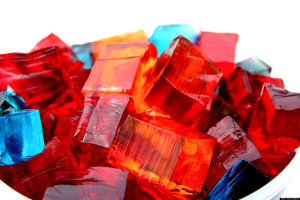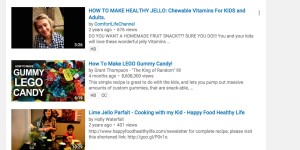When I first came to United States, one thing that surprises me a lot when we have meals is the jello. Growing up in China, I was educated that anything with artificial color are bad for your health. Therefore I always had the preconception that jello  is evil. However things may be a little different in the States I guess. When I went online to search if jello is good for kids or not, I found these on youtube. “How to make a healthy Jello”, “cooking a
is evil. However things may be a little different in the States I guess. When I went online to search if jello is good for kids or not, I found these on youtube. “How to make a healthy Jello”, “cooking a
 healthy diet with jello”, “they love jello” and etc. So I started to ask myself is jello really a healthy food? Since from what I found online people had been claiming it is delicious and low fat.
healthy diet with jello”, “they love jello” and etc. So I started to ask myself is jello really a healthy food? Since from what I found online people had been claiming it is delicious and low fat.
It seems like little amount of people nowadays realized that jello is made of various chemicals. While it melt in your mouth, you are not eating something fun but something toxic. Here’s what I found online.  This box of jello is made of these following ingredients:”Gelatin, artificial flavor, red #40, artificial food dyes, BHA, GMO sugar and various preservatives.”
This box of jello is made of these following ingredients:”Gelatin, artificial flavor, red #40, artificial food dyes, BHA, GMO sugar and various preservatives.”
Galatin
Artificial flavor and Red#40 are both made of petroleum. Red#40  is one of the most common artificial color that is used in the US. One study that was conducted in 1980s suggested that “red number 40 may accelerate the appearance of immune system tumors in mice”. A widely accepted concept is that Red number 40 might trigger hyper-activity in children. Various study had been done on the artificial color and turned out to have different result. While some had proven that artificial color had negative effect on children which may lead them to attention deficit hyperactivity disorder, others had shown that artificial colors have no effect on children. One thing is certain, consuming a big amount of artificial color is never healthy for body and have negative influence on immune system. An article on Boston Globe had pointed out that “A handful of clinical trials found that a small percentage of children experience attention problems and aggressive behavior when they consume 35 mg a day of synthetic coloring, while a larger percentage experiences behavioral problems at doses of 100 mg a day or higher.” Interestingly, study from Purdue University indicated that how much artificial dyes were contained in children’s daily meal. It had also shown that “8 percent of ADHD cases are due to artificial dyes in diet”. From what we had learned in class, since the percentage is above 5 percent, this cases this study had observed may not be a fluke therefore proven a correlation that artificial dyes do cause problems to kids.
is one of the most common artificial color that is used in the US. One study that was conducted in 1980s suggested that “red number 40 may accelerate the appearance of immune system tumors in mice”. A widely accepted concept is that Red number 40 might trigger hyper-activity in children. Various study had been done on the artificial color and turned out to have different result. While some had proven that artificial color had negative effect on children which may lead them to attention deficit hyperactivity disorder, others had shown that artificial colors have no effect on children. One thing is certain, consuming a big amount of artificial color is never healthy for body and have negative influence on immune system. An article on Boston Globe had pointed out that “A handful of clinical trials found that a small percentage of children experience attention problems and aggressive behavior when they consume 35 mg a day of synthetic coloring, while a larger percentage experiences behavioral problems at doses of 100 mg a day or higher.” Interestingly, study from Purdue University indicated that how much artificial dyes were contained in children’s daily meal. It had also shown that “8 percent of ADHD cases are due to artificial dyes in diet”. From what we had learned in class, since the percentage is above 5 percent, this cases this study had observed may not be a fluke therefore proven a correlation that artificial dyes do cause problems to kids.
In addition, some flavors of jello also contain blue#1  in it which the FDA had been advocating the prohibition of this artificial dye since 2003 because “patients were dying from refractory hypotension and metabolic acidosis which was caused by blue number 1.”
in it which the FDA had been advocating the prohibition of this artificial dye since 2003 because “patients were dying from refractory hypotension and metabolic acidosis which was caused by blue number 1.”
One thing that Jello has the most is sugar. “One serving of Jello contains 19 grams of sugar, which is five teaspoon.” Convert into calories is 74 cal, opposing from their slogan “0 calories”. A Study done by Dana Dabelea, a professor in Colorado School of Public Health in Aurora, had indicated that from 2000 to 2009, type 2 childhood diabetes had increased for 30%, greatly associated with the sugar consumption among children. Although companies used “cane sugar” in their products, some pointed out that they mostly used genetic modified corn in order to have higher production and lower cost. A rat feeding study done by Professor Gilles-Eric Séralini had shown result that genetic modified maize are proven toxic to the rats.
The purpose of this is not to inform and discuss how toxic are jello to children or genetic modified crops. I only want to point out that jello is not good for kids to consume because it is not healthy for their development unlike the parents assumed. Therefore can conclude that Jello is not good for kids.

Pingback: Sugar is the Cocaine of the Food Industry – But It Tastes So Good
First off, you seriously had NEVER eaten anything with artificial coloring while you lived in China? Doesn’t everything have something that’s artificially colored? That just blows my mind. But after reading your blog I’m starting to rethink what I eat. I like your point about the five tablespoons of sugar that equal to about 74 calories which contradicts their slogan. Could we say this is false advertising? You could possibly take down the Jell-O industry.
All I can say is WOW. I never really enjoyed Jell-O as a child, because I was very healthy (I would pick an apple over candy any day, yes I realize I was one of the only children to ever do this). I knew Jell-O contained a lot of “nothing” aka no substance and assumed it wasn’t very healthy, but still WOW. I can’t believe how unhealthy Jell-O is and how bad it can be for anyone, especially kids (because that seems to be their target market). People always talk about how packaging and marketing are what make a parent buy the product, not what’s actually inside. I am just shocked to learn Jell-O is actually incredibly bad for you. This specific article (http://www.livescience.com/14280-parents-feed-kids-junk.html) focuses on how parents are giving their kids a bad diet not to harm them, but simply out of convenience. Kids are also just more likely to be attracted to a colorful box describes as sweet rather than a bag of carrots or something with a healthy connotation. Again, this blog post might have been one of the most interesting–and shocking–blogs I have read. Thank you!